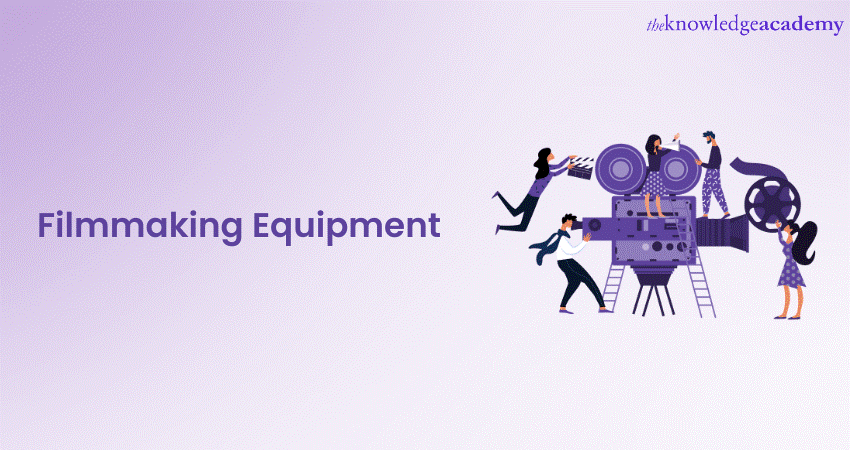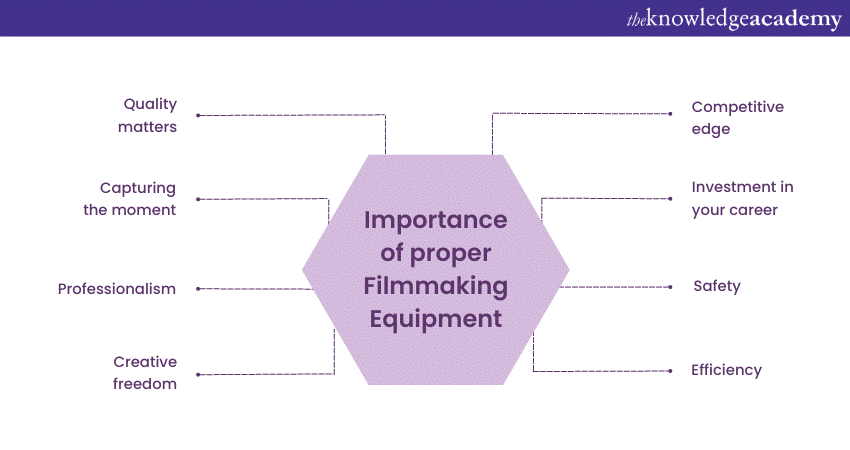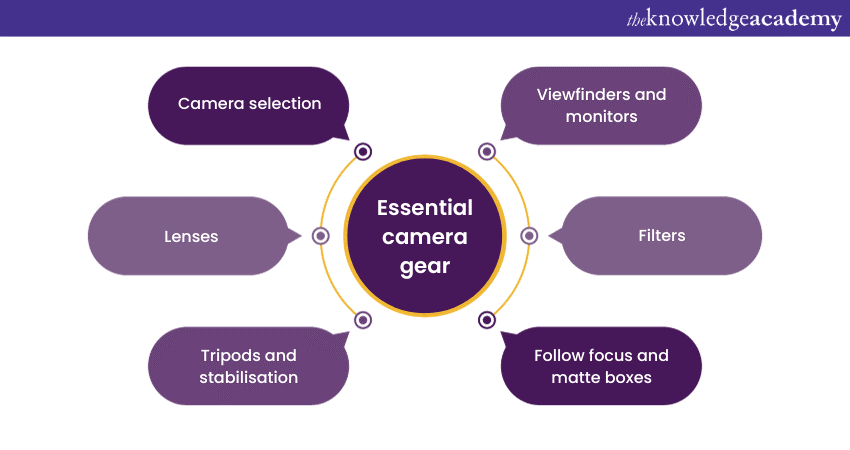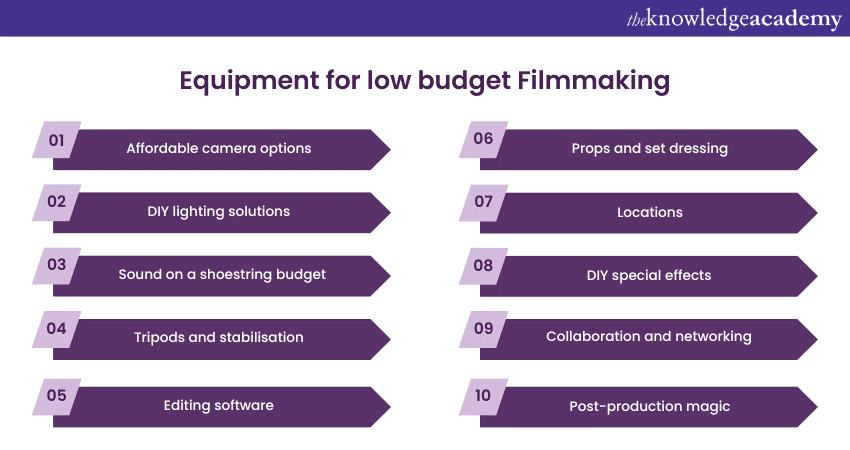We may not have the course you’re looking for. If you enquire or give us a call on +353 12338944 and speak to our training experts, we may still be able to help with your training requirements.
We ensure quality, budget-alignment, and timely delivery by our expert instructors.

Filmmaking is an art that combines creativity with technology, and having the right Filmmaking Equipment is crucial to bring your vision to life. From the camera to the detailed lighting arrangements and the precise audio recording devices, every piece of equipment plays a vital role in creating an engaging story on the big screen.
In this blog, you’ll explore the significance of Filmmaking Equipment - from cameras to lighting, and understand how gear shapes cinematic storytelling. Get started in the Film industry!
Table of Contents
1) Importance of proper Filmmaking Equipment
2) Essentials of camera gear
3) Audio Equipment
4) Lighting Equipment
5) Equipment for low-budget Filmmaking
6) Conclusion
Importance of proper Filmmaking Equipment
If you are a Filmmaker or someone aspiring to make a significant impact in the Film industry, it is crucial to recognise the significance of Filmmaking Equipment and its various uses. Here, we will explore the importance of possessing the right Filmmaking gear:

a) Quality matters: Good Filmmaking Equipment ensures that your videos or movies look and sound great. If you use subpar equipment, your work might end up blurry, shaky, or with bad sound quality. Imagine watching a movie where you can't hear what the actors are saying – it wouldn't be much fun, would it?
b) Capturing the moment: Filmmaking often involves capturing real-life moments and emotions. If your camera or microphone isn't up to the task, you might miss those special moments forever. Proper equipment helps you capture the magic of the moment.
c) Professionalism: If you want your work to be taken seriously, you need to look and sound professional. High-quality equipment can make your films or videos look like they were made by experts, even if you're just starting out.
d) Creative freedom: Good Filmmaking Equipment gives you more options. You can experiment with different shots, lighting, and sound effects. It's like having a bigger canvas for a painter – you can create more and better art.
e) Efficiency: Filmmaking can put in a lot of hard work, but the right Filmmaking Equipment can make it easier. It helps you work faster and more efficiently. Imagine trying to build a house with a tiny hammer – it would take forever! Proper equipment is like having the right tools to get the job done quickly.
f) Safety: Some equipment, like tripods and stabilisers, not only improve the quality of your work but also keep you safe. They prevent accidents and injuries on set. Safety is always important!
g) Investment in your career: Buying good Filmmaking Equipment is like an investment in your Filmmaking career. As you learn and grow, your equipment can grow with you. You won't have to replace it as often, which can save you money in the long run.
h) Competitive edge: In Filmmaking, there's a lot of competition. Using proper equipment can give you an edge. Your work will stand out because it looks and sounds better than the rest.
Essentials of camera gear
When it comes to Filmmaking, the camera is your most vital tool. To capture stunning visuals and bring your creative vision to life, you need the right camera gear. Here, we'll delve into the basic Filmmaking Equipment list:

Camera selection
The heart of your Filmmaking setup is, of course, the camera itself. There are various types of cameras available, from DSLRs to cinema cameras. Your choice depends on factors like your budget and the type of Filmmaking you intend to do. DSLRs are a popular choice for beginners due to their affordability and versatility, while cinema cameras are designed for professional Filmmaking and offer exceptional image quality.
Lenses
Lenses play a significant role in determining the look and feel of your footage. Different lenses provide various focal lengths, apertures, and characteristics, allowing you to achieve specific visual effects. A standard zoom lens is versatile for a wide range of shots, but prime lenses with fixed focal lengths can offer superior image quality and creative options.
Tripods and stabilisation
Keeping your shots steady is crucial for professional-looking footage. Tripods are essential for static shots, while stabilisers like gimbals or steadicams help you capture smooth, handheld shots and dynamic camera movements.
Follow focus and matte boxes
For precise control over focus and to minimise glare or lens flares, consider using a follow focus system and a matte box. These accessories enhance the quality of your shots and allow for more creative control.
Filters
Filters are essential for adjusting the light that enters your lens. Neutral density (ND) filters, for example, reduce the amount of light, allowing you to use wider apertures and slower shutter speeds for creative effects. Polarising filters reduce reflections and enhance colours, while UV filters protect your lens.
Viewfinders and monitors
These tools help you frame your shots accurately and monitor your footage in real-time. Viewfinders attach to your camera's LCD screen, providing a clearer view in bright conditions. External monitors offer a larger, more detailed display.
Audio Equipment
Capturing clear and high-quality audio is just as important as having a good camera. Sound can make or break a film, so it's crucial to invest in the right audio equipment. Here, we’ll understand what constitute audio equipment:
Microphones
Microphones are the primary tools for recording audio in Filmmaking. There are various types to consider:
a) Shotgun microphones: These are highly directional microphones that capture sound from a narrow area. They're excellent for picking up specific sounds or dialogue while minimising background noise.
b) Lavalier microphones (lapel mics): These small, discreet microphones clip onto the actor's clothing and are commonly used for interviews and dialogue. They provide close-up, clear sound.
c) Boom microphones: A boom microphone, often mounted on a boom pole, is commonly used to capture audio on film sets. The operator holds the boom pole above the actors, positioning the microphone close to the action while staying out of the frame.
d) Wireless microphone systems: These systems allow for greater mobility as they don't require a physical connection to the camera or recording device. They are popular for capturing audio from moving subjects.
Audio recorders
While some cameras have built-in audio recording capabilities, dedicated audio recorders offer superior sound quality and flexibility. They allow you to record multiple audio tracks simultaneously, adjust audio levels, and monitor sound in real-time. Popular options include portable audio recorders like the Zoom H4n or dedicated field recorders like the Sound Devices 633.
Headphones
Monitoring your audio while recording is essential to catch any issues, such as interference or background noise. Invest in closed-back headphones with good isolation to help you hear the audio clearly and make real-time adjustments.
Level up your music production skills with our Music Production Masterclass today and compose your own musical journey!
Lighting Equipment
The proper use of Lighting Equipment is essential for achieving professional results. It allows you to set the mood, direct attention, and create a visually captivating story. Here’s what constitute Lighting Equipment:
Continuous lighting vs. Strobes/flashes
Filmmakers primarily use continuous lighting, which provides a constant source of illumination. Unlike strobes or flashes used in photography, continuous lighting allows you to see how the light affects your scene in real-time.
Key lights
The key light is the primary source of illumination for your subject. It establishes the main direction and intensity of light, shaping the subject's features and defining their presence on screen.
Fill lights
Fill lights are used to soften shadows created by the key light. They help to maintain detail in darker areas of the scene and create a more balanced, pleasing look.
Backlights (rim lights)
Backlights are positioned behind the subject and provide separation between the subject and the background. They create a rim of light around the subject, adding depth and dimension to the shot.
Modifiers
Lighting modifiers allow you to shape and control the quality of light. Common modifiers include:
a) Softboxes: Soften and diffuse light, reducing harsh shadows and creating a flattering, even illumination.
b) Umbrellas: Reflect or shoot light through them to achieve softer, more diffused lighting.
c) Reflectors: Bounce light back onto the subject, filling in shadows and reducing contrast.
d) Gels: Add coloured effects to the light for creative or corrective purposes.
Light Meters
Music Production Equipment helps you measure and control the intensity of your lights, ensuring consistent lighting throughout your shoot. They are especially valuable in achieving precise exposure and matching lighting across multiple scenes.
Dimmers and lighting control systems
Dimmers allow you to adjust the brightness of your lights easily. More advanced lighting control systems enable you to fine-tune and automate lighting setups for complex scenes.
Equipment for low budget Filmmaking
Low budget Filmmaking often requires creative solutions and careful allocation of resources. While you may not have access to high-end equipment, there are still effective ways to produce quality Films without breaking the bank. Let's explore the essential equipment and strategies for low budget Filmmaking:

Affordable camera options
Instead of expensive cameras, you can use more affordable ones like basic DSLRs (those are the types of cameras people use for photography) or even your smartphone. These options are budget-friendly and can still capture good-quality video.
DIY lighting solutions
You don't need fancy lighting equipment. You can use natural light from the sun, which is free! For indoor scenes, you can create your own lighting setups using everyday items like household lamps and bedsheets to soften and shape the light.
Sound on a shoestring budget
You can improve the sound quality without spending a lot by getting budget-friendly external microphones. Also, instead of recording all the sounds during filming, you can add some sounds later when you're editing your film. This is called "foley" and can save you money.
Tripods and stabilisation
To avoid shaky shots (which can look amateurish), you can make your own stabilisers using things you already have around the house. This way, you don't need to buy expensive stabilising equipment.
Editing software
You don't have to spend a lot on fancy editing software. There are free or low-cost programs available that have all the tools you need to edit your film and make it look great.
Props and set dressing
Instead of buying expensive props and set decorations, you can get creative by using items you already have or by finding affordable items at thrift stores or garage sales. It's all about making the most of what's available.
Locations
You can save money on filming locations by choosing public places that you don't have to pay for. Also, try to film during the "golden hours" of the day (early morning) when natural light is soft and flattering.
DIY special effects
Special effects don't have to be expensive. You can make your own effects using everyday items. For example, you can use flour to create the look of falling snow, or you can use a green piece of fabric as a background for adding cool effects later.
Collaboration and networking
Filmmaking is often a collaborative effort. You can work with other people who share your passion for making Films. By pooling resources and trading services or equipment, you can make the most of what you have.
Post-production magic
After Filming, you can use editing techniques to enhance your Film. For instance, you can change the colours or improve the sound quality to give your Film a more professional and cinematic look and sound. Post-production is where you add the finishing touches to your Film.
Conclusion
Filmmaking Equipment are like a Filmmaker's best friends, helping visual storytelling, enhancing audio quality, and bringing creative visions to life. From cameras and lenses to microphones and lighting, each piece plays a vital role in the Filmmaking process. Investing in quality equipment not only improves the overall production value but also enhances storytelling capabilities.
Explore your passions and enhance your skills with our diverse range of Hobbies and Interests Courses!
Frequently Asked Questions
What are the Other Resources and Offers Provided by The Knowledge Academy?

The Knowledge Academy takes global learning to new heights, offering over 3,000 online courses across 490+ locations in 190+ countries. This expansive reach ensures accessibility and convenience for learners worldwide.
Alongside our diverse Online Course Catalogue, encompassing 19 major categories, we go the extra mile by providing a plethora of free educational Online Resources like News updates, Blogs, videos, webinars, and interview questions. Tailoring learning experiences further, professionals can maximise value with customisable Course Bundles of TKA.
Upcoming Business Skills Resources Batches & Dates
Date
 Basic Barista Course
Basic Barista Course
Fri 21st Feb 2025
Fri 25th Apr 2025
Fri 20th Jun 2025
Fri 29th Aug 2025
Fri 31st Oct 2025
Fri 19th Dec 2025






 Top Rated Course
Top Rated Course



 If you wish to make any changes to your course, please
If you wish to make any changes to your course, please


